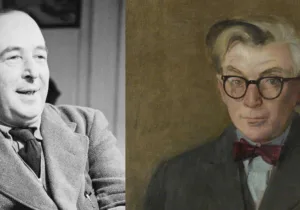If the morality of a cause could be judged simply from the proportion of intelligent and creative people who support it, then the Eugenics movement of the early twentieth century most assuredly would have been among the most righteous crusades in modern history. Among its supporters were presidents, prime ministers, economists, professors of law and medicine, Nobel laureates, and many of the greatest names in contemporary finance, philanthropy, literature, and art. When Supreme Court Justice Oliver Wendell Holmes Jr., in his majority opinion on the notorious Buck vs. Bell case, wrote that “Society can prevent those who are manifestly unfit from continuing their kind…Three generations of imbeciles are enough”, he spoke not only for himself and the seven other majority justices who decided as he did in the case, but for perhaps for the greater part of educated American citizens as well.
Twelve years earlier, on the other side of the Atlantic, Virginia Woolf recorded in her personal journal a description of a recent encounter that had been particularly distasteful to her: out for a Sunday walk with her husband Leonard, she had passed “a long line of imbeciles”, whose existence, she forthrightly states, struck her as an offense: “One realized that everyone in that long line was a miserable, ineffective, shuffling, idiotic creature with no forehead, or no chin, and an imbecile grin, or a wild suspicious stare. It was perfectly horrible.” Before moving on to less remarkable observations, Woolf concludes the passage unforgettably: “They should certainly all be killed.”
Woolf’s Bloomsbury cohort John Maynard Keynes, probably the most influential Anglophone economist of his generation, was no less a true believer in the rightness of the crusade. While serving as the treasurer of the Cambridge University Eugenics Society, Keynes cast an alarmed eye toward the future and found it rather too thickly populated. An ameliorative plan of action he announced in a 1914 speech to the organization: “In most places the material condition of mankind is inferior to what it might be if their populousness were to be diminished…In many, if not in most, parts of the world there actually exists at the present time a denser population than is compatible with a high level of economic wellbeing.” Wendell Holmes, Woolf, Keynes, and other equally refined intellects of the hour were agreed on this article of faith: that the world must be unpeopled. So much was obvious to all but the backward and the superstitious.
As a further source of strength, the attractions of Eugenics were impressively ecumenical. It is of course conveniently argued today by partisans of the right and of the left that the ideology was fundamentally socialist in its origins, or fundamentally reactionary, depending on whose convenience is best served. But, in truth, Eugenicists wore all manner of party labels and sectarian colors. In their ranks were both Republican and Democrat, nationalist and radical, Liberal and Tory. The movement’s latitude of appeal may be appreciated by considering two anecdotes: in 1917, William Ralph Inge, the patrician and Protestant Dean of St. Paul’s, published a determined essay on the necessity of defending the ascendency of the white man against the rise of the darker races. In that same year, the Anarchist leader Eugene Debs contributed to the Birth Control Review an encomium dedicated to “Comrade Sanger” and her noble labor in the vineyard of scientific birth control. For all of its narrowly elitist aims, there was a perverse catholicity in the appeal of the gospel of sterilization.
The study of the movement and its supporters may leave the interested student curious as to the nature of the opposition. Whether we feel that the controlled and methodical “improvement” of the species was right or wrong, it ought to be obvious that to stand against it was to oppose not only a scientific doctrine, but that much more powerful thing: a social fashion whose followers included nearly all the tenured experts and bright sophisticates of the world’s wealthier nations. As often happens at the appearance of some new and stylish evil, articulate dissent was slow to reply. This fact might exasperate, but need not surprise us. Probably had our generation then been living we would have done no better. Unglamorous plain truth usually counts on fewer allies than noisy modishness, and it would be valuable, if depressing, to know how many people over the centuries have made a permanent wreck of their honor in the name of a temporary vogue.
G.K. Chesterton was never fashionable while living. This may be one reason why we still read him now that he is dead. It happened that he was approaching the high crest of his literary ability when the Eugenicists were nearing the peak of their social influence. Once Chesterton recognized the moral consequences of that influence, his antagonism to it was unyielding and unequivocal. The fullest statement of his opposition to the great herd-thinning experiment appears in his 1922 book Eugenics and Other Evils. Of his several works dedicated to social issues, this remains one of the liveliest and most combative. It is evident on every page that Chesterton was conscious that to stand for one side or the other was to stand not for a relative convenience or inconvenience, but for good or evil in forms as absolute as can be found. In attacking, Chesterton is cheerfully unsparing and generously fanatical. He is at war with an evil idea rather than with its particular supporters. In his enemy he sees a new form of slavery as well as a false scientism, and a slavery all the more insidious for the halo of humanitarian rhetoric that surrounds it.
To Chesterton, it was obvious that this theory supplies the well-to-do with another instrument for the manipulation of the poor; the thing in question may even be more pernicious than certain older oppressions, such as sweated labor and penal transportation, for in Eugenics lies an evil that is allegedly exercised for the benefit of its victims and advocates. To defend it is to cover naked cruelty with a mendacious veneer of public-spirited virtue. To excuse its sins against the innocent and the weak is to sign a careless benediction over what Chesterton refers to as the “anarchy from above”, the irresponsible experimentation of privileged sophistry on powerless Everyman and Everywoman. Eugenics and Other Evils is not a long book; therefore it is all the more impressive how much of his enemies’ wooly reasoning Chesterton unravels, and how many fallacies he is able to expose. The book is a small masterpiece of the polemicist’s art.
No book ever ends a battle, even if certain have begun them. Chesterton died when Eugenics had still to enjoy its hour of darkness in Belsen and Buchenwald. After these and other monstrosities of National Socialism were brought to light and judged, the cause was compelled to change its language and its colors. Yet it is nonetheless alive. Whether any controversialist of Chesterton’s strength remains to fight it is a more doubtful question.






 Sponsor a student for Christianity & National Security 2024
Sponsor a student for Christianity & National Security 2024